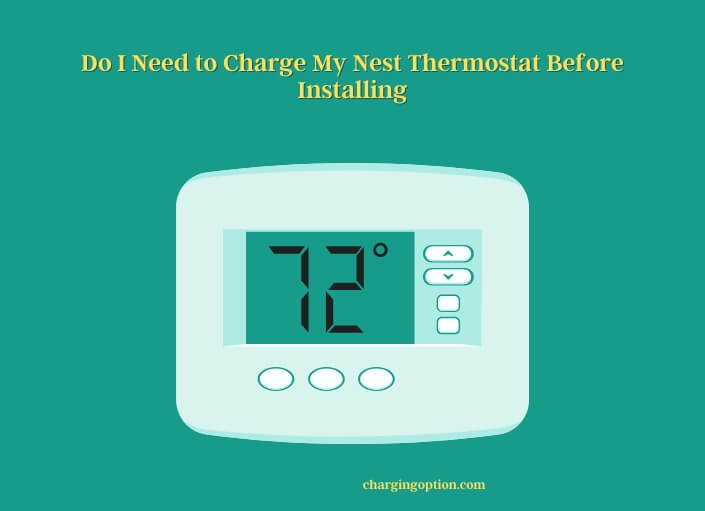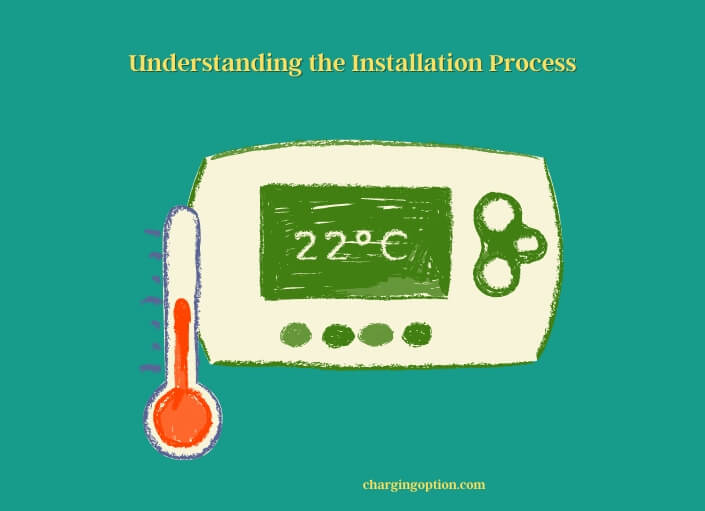We’ve all been there – standing with a new gadget in hand, thumbing through its manual, and coming across a question that seems crucial yet confusing. If you’re on the brink of installing a Nest Thermostat and find yourself asking, “Do I need to charge my Nest Thermostat before installing?” you’ve landed at the right spot. In this guide, we’ll demystify your thermostat installation journey.

Do I Need to Charge My Nest Thermostat Before Installing?
It’s a valid question and the answer is simpler than you might expect. No, you don’t need to charge your Nest Thermostat before installing it. The device has a built-in rechargeable lithium-ion battery that charges itself when connected to your HVAC system’s wires.
Nest Thermostat’s Battery
The Nest Thermostat is a nifty little device that doesn’t require an external power source or routine charging like our smartphones or laptops. How cool is that? Its built-in lithium-ion battery automatically charges via the low-voltage wires connected to your HVAC system. If there’s an interruption in the power, the battery retains enough juice to keep your Nest Thermostat going for a bit.
The Charging Process
Though you won’t need to charge the Nest Thermostat manually, it’s a good idea to understand how the charging process works. The Nest’s internal battery is typically charged by the C (or Common) wire from your HVAC system. In cases where the C wire isn’t available, the Nest can also charge using the R and W (or Y) wires, although this isn’t the preferred method.
Installing Without a Charge
Yes, you read that right! You can indeed install the Nest Thermostat without pre-charging. Its built-in battery has enough power to get you through the initial setup and installation process. Once the device is correctly wired into your HVAC system, the battery will recharge itself.
The Installation Process
Knowing the basics of installation can help you set up your Nest Thermostat with confidence. So, let’s take a deeper look at each step.

Preparation
Before getting started with the installation, you’ll want to ensure your home’s HVAC system is compatible with the Nest Thermostat. Nest’s website provides a compatibility checker for this purpose. Once compatibility is confirmed, take a snapshot or jot down the wiring configuration of your existing thermostat – this can be a lifesaver during the installation process.
Initial Setup
The initial setup involves adding the Nest Thermostat to your Nest account via the Nest app. If you don’t already have an account, you’ll need to create one. Once signed in, select “Add product” and scan the QR code on your Nest Thermostat’s packaging. This will pair the device with your account and prompt you to enter the device’s key. Once the device is added, you can proceed to install it physically.
Installation
This is where the rubber meets the road. Here’s a more detailed breakdown of the installation steps:
- Power Off: Start by turning off the power to your HVAC system. This step is crucial for your safety and to prevent damage to your HVAC system and the Nest Thermostat.
- Remove Old Thermostat: Remove the old thermostat, being careful not to disconnect any wires just yet. Now’s the time to refer to that snapshot or note of the wiring configuration.
- Install the Nest Base: Next, install the Nest base on your wall. Use the included screws to secure it in place. Make sure it’s level by using the built-in bubble level. Once it’s securely fastened, you can thread the wires through the center.
- Connect the Wires: Now, connect the wires to the matching terminals on the Nest base. Use the simple press-down connectors to secure each wire. It’s important to make sure each wire is snugly connected.
- Attach the Nest Display: Once the wires are secured, you can attach the Nest display. It should easily click into place on the base.
- Power On: With everything in place, you can now turn the power back on to your HVAC system.
Post-Installation Setup
Now that your Nest Thermostat is physically installed, there are a few more steps to get it fully operational:
- Choose Your Language: Your Nest Thermostat will power up and ask you to choose a language.
- Internet Connection: Connect the device to your Wi-Fi network. This allows you to control your Nest Thermostat remotely and receive software updates.
- Location: Set your location. This helps the thermostat adjust to your local weather conditions and optimize its energy-saving features.
- Temperature Preferences: Set your preferred temperatures for when you’re at home, away, or asleep.
- Software Update: Check for any available software updates and download them.
And there you have it! Your Nest Thermostat should now be fully operational.
Frequently Asked Questions
Do I need to charge my Nest Thermostat before installing?
No, the Nest Thermostat doesn’t require manual charging before installation. Its battery automatically recharges when connected to your HVAC system.
What happens if the Nest Thermostat’s battery dies?
If the battery runs out of charge, your thermostat will stop working until it’s recharged. However, this is unlikely unless there’s a sustained power outage as the thermostat recharges itself when wired to your HVAC system.
Can I install the Nest Thermostat myself?
Yes, you can. Nest provides a detailed step-by-step guide in the manual and the Nest app. However, if you’re uncomfortable with the process or if your HVAC system is complex, it’s best to hire a professional.
How long does the Nest Thermostat’s battery last on a full charge?
The internal battery typically lasts for about a year but this can vary depending on usage and power supply.
How can I tell if my Nest Thermostat is charging?
The Nest Thermostat does not display a charging icon, unlike a smartphone. However, if it’s properly connected to the HVAC wires, rest assured it’s charging.
What should I do if my Nest Thermostat isn’t turning on?
Check if the HVAC system’s power is on and the thermostat is properly wired. If the issue persists, it may be a hardware problem, and it’s best to reach out to Nest’s support team.
Does Nest Thermostat work if the Wi-Fi is down?
Absolutely! Your Nest Thermostat will continue to operate even without Wi-Fi, maintaining the most recent schedule programmed into it. However, without Wi-Fi, you won’t be able to control it remotely or receive software updates.
Can the Nest Thermostat operate on battery power alone?
While Nest Thermostat does have a built-in rechargeable battery, it’s not designed to run solely on battery power. It requires a constant low-voltage power supply from your HVAC system to function optimally.
What to do if my Nest Thermostat is not charging?
If your Nest Thermostat’s battery isn’t charging, check the wiring. Make sure the C wire is correctly connected. If issues persist, you may want to get a professional involved or contact Nest Support.
Do I need to regularly replace the Nest Thermostat’s battery?
No, the Nest Thermostat’s battery isn’t designed to be user-replaceable. It recharges itself through your HVAC system’s wiring, thus eliminating the need for frequent replacements.
Can I use a power adapter to charge my Nest Thermostat?
While there are third-party power adapters available, it’s not recommended to use them. The Nest Thermostat is designed to be powered directly from your HVAC system. Using a power adapter could potentially harm your thermostat and void the warranty.
Is there a way to manually check the battery level on the Nest Thermostat?
You can check your Nest Thermostat’s battery voltage via the settings on the device itself or through the Nest app. If the voltage drops below 3.6V, it means the battery is critically low.
Conclusion
Setting up your Nest Thermostat doesn’t have to be a daunting task. By now, it should be clear that you do not need to charge your Nest Thermostat before installing it. The device is smartly designed to handle its power needs through the HVAC system once installed correctly.
Remember, if you’re unsure about anything during the installation process, there’s no harm in reaching out to a professional. After all, the aim is to create a comfortable and energy-efficient environment in your home.
Remember, there’s no such thing as a stupid question. If you’re not sure, ask. It’s better to be safe than sorry.
Read more:
